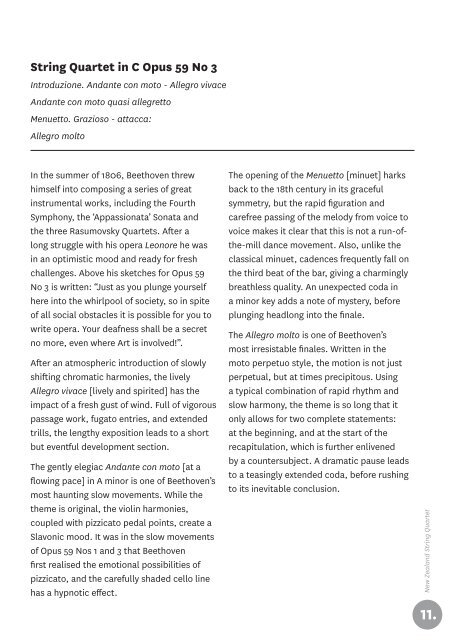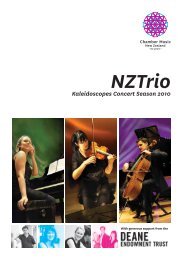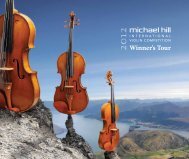BEETHOVEN! - Chamber Music New Zealand
BEETHOVEN! - Chamber Music New Zealand
BEETHOVEN! - Chamber Music New Zealand
You also want an ePaper? Increase the reach of your titles
YUMPU automatically turns print PDFs into web optimized ePapers that Google loves.
String Quartet in C Opus 59 No 3<br />
Introduzione. Andante con moto - Allegro vivace<br />
Andante con moto quasi allegretto<br />
Menuetto. Grazioso - attacca:<br />
Allegro molto<br />
In the summer of 1806, Beethoven threw<br />
himself into composing a series of great<br />
instrumental works, including the Fourth<br />
Symphony, the ‘Appassionata’ Sonata and<br />
the three Rasumovsky Quartets. After a<br />
long struggle with his opera Leonore he was<br />
in an optimistic mood and ready for fresh<br />
challenges. Above his sketches for Opus 59<br />
No 3 is written: “Just as you plunge yourself<br />
here into the whirlpool of society, so in spite<br />
of all social obstacles it is possible for you to<br />
write opera. Your deafness shall be a secret<br />
no more, even where Art is involved!”.<br />
After an atmospheric introduction of slowly<br />
shifting chromatic harmonies, the lively<br />
Allegro vivace [lively and spirited] has the<br />
impact of a fresh gust of wind. Full of vigorous<br />
passage work, fugato entries, and extended<br />
trills, the lengthy exposition leads to a short<br />
but eventful development section.<br />
The gently elegiac Andante con moto [at a<br />
fl owing pace] in A minor is one of Beethoven’s<br />
most haunting slow movements. While the<br />
theme is original, the violin harmonies,<br />
coupled with pizzicato pedal points, create a<br />
Slavonic mood. It was in the slow movements<br />
of Opus 59 Nos 1 and 3 that Beethoven<br />
fi rst realised the emotional possibilities of<br />
pizzicato, and the carefully shaded cello line<br />
has a hypnotic eff ect.<br />
The opening of the Menuetto [minuet] harks<br />
back to the 18th century in its graceful<br />
symmetry, but the rapid fi guration and<br />
carefree passing of the melody from voice to<br />
voice makes it clear that this is not a run-ofthe-mill<br />
dance movement. Also, unlike the<br />
classical minuet, cadences frequently fall on<br />
the third beat of the bar, giving a charmingly<br />
breathless quality. An unexpected coda in<br />
a minor key adds a note of mystery, before<br />
plunging headlong into the fi nale.<br />
The Allegro molto is one of Beethoven’s<br />
most irresistable fi nales. Written in the<br />
moto perpetuo style, the motion is not just<br />
perpetual, but at times precipitous. Using<br />
a typical combination of rapid rhythm and<br />
slow harmony, the theme is so long that it<br />
only allows for two complete statements:<br />
at the beginning, and at the start of the<br />
recapitulation, which is further enlivened<br />
by a countersubject. A dramatic pause leads<br />
to a teasingly extended coda, before rushing<br />
to its inevitable conclusion.<br />
<strong>New</strong> <strong>Zealand</strong> String Quartet<br />
11.





